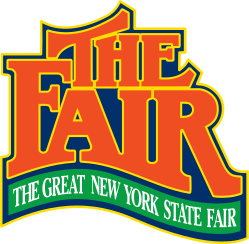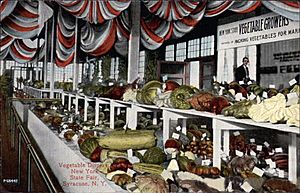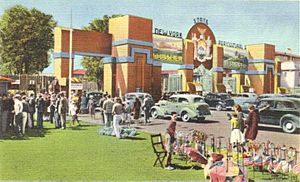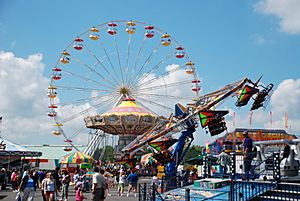New York State Fair facts for kids
Quick facts for kids New York State Fair |
|
|---|---|
 |
|

The fair in 2008
|
|
| Status | Active |
| Genre | State Fair |
| Begins | Second Wednesday before Labor Day |
| Ends | Labor Day |
| Frequency | Annual |
| Location(s) | Empire Expo Center 581 State Fair Blvd Syracuse, New York 13209 |
| Years active | 183 |
| Inaugurated | September 29, 1841 |
| Founder | New York State Agricultural Society |
| Attendance | 878,110 (2023) |
| Website | New York State Fair |
The New York State Fair, also called the Great New York State Fair, is a huge 13-day event. It shows off farming, fun entertainment, learning, and new technology. With exciting midway rides, tasty food, cool exhibits, and live concerts, it is New York's biggest yearly event. It is a favorite end-of-summer tradition for many families.
The first fair happened in Syracuse in 1841. It moved to its permanent home there in 1890. It is one of the oldest and largest state fairs in the United States. Over one million people visit it every year.
The New York State Fair starts in August and runs for 13 days. It always ends on Labor Day. The fair did not happen in 2020 because of the COVID-19 pandemic.
It is held at the 375-acre (152 ha) Empire Expo Center. This center is on the shores of Onondaga Lake. It is in the town of Geddes, near Syracuse. The New York State Department of Agriculture and Markets owns five of the fair's buildings. They also employ its workers.
Contents
History of the New York State Fair
In February 1832, the New York State Agricultural Society was started. A group of farmers and lawmakers created it in Albany. Their goal was to make farming better and to support local fairs.
The very first state fair in the nation was held in Syracuse. It took place from September 29–30, 1841. About 10,000 to 15,000 people attended. It featured speeches, animal shows, a plowing contest, and samples of farm and home goods. The second New York State Fair was in Albany in 1842.
Between 1842 and 1889, the fair moved around. It visited 11 different cities. These included Albany, Buffalo, New York City, and Syracuse.
In September 1890, the Syracuse Land Company gave 100 acres of land to the Agricultural Society. This land was in Geddes. It was a great spot because railways crossed it, making it easy to bring exhibits. This location in Onondaga County became the fair's permanent home.
In the late 1890s, the Agricultural Society needed help with debt. They had built many permanent buildings. So, the state government bought the grounds in 1899. The state then took over running the fair in 1900.
A big $2 million building plan started in 1908. It lasted for 20 years. During this time, the Manufacturers and Liberal Arts Building was built. It is now called the Center of Progress Building. The Dairy Products Building and Grange Building (now Science & Industry Building) were added in 1910.
During World War I, the fairgrounds were used for military training. This started in May 1917. It was called Camp Syracuse. About 40,000 soldiers trained there. The base closed in November 1918.
The Coliseum opened in 1923. It first hosted the World's Dairy Congress. In 1928, an Iroquois village exhibit and a farming museum opened. This showed people more about local history.
The fair changed its name in 1938. It became the New York State Agricultural and Industrial Exposition. This showed its new ties to industry. It also had a longer 14-day schedule with popular entertainment.
The fairgrounds were used as a military base again. This was during World War II from 1942 to 1947. No fair was held during these years. A shorter fair returned in 1948. The next year, a six-day, full fair happened with many visitors. By the late 1950s, the fair was nine days long. It had over 500,000 visitors. The James E. Strates Midway was added. Famous entertainers came to attract families and teens.
In 1967, a special 1925 Mighty Wurlitzer Theatre Pipe Organ was installed. It is in the Empire Theatre. It has entertained audiences for over 50 years.
From 1962 to 1966, the fair was called New York State Exposition. It was renamed the New York State Fair in 1967.
The fair grew to 10 days in 1978. Buildings at the fairgrounds started to be rented out when the fair was not happening. In 1990, the fair became 12 days long. During the 1980s and 1990s, the fair added gospel festivals and a Pan-African village. This was to include more diverse groups. Sign language interpreters were also added. The grounds became easier for people with disabilities to use.
On September 7, 1998, the fair closed a day early. This was because of a big storm called the Syracuse Labor Day derecho. Two people died at the fairgrounds during this storm.
In 2008, the fair started to focus more on farming. Exhibits showed products made in New York State. These included the Pride of New York Marketplace. A permanent maple exhibit was also added. In 2009, Chevy Court began having two different performers each day.
A big $50 million plan to improve the Fairgrounds was announced. This was on January 21, 2015. It was the first major update in over 100 years.
The fair broke its old attendance record from 2001. On September 5, 2016, 1,117,630 people visited the fair. The 2016 Fair also broke three daily attendance records. It had four days with over 100,000 visitors.
In 2017, the fair was made even longer. It became 13 days. Chevy Court set its newest attendance record on September 2, 2018. About 40,000 people watched a performance by A Boogie Wit Da Hoodie.
On July 6, 2020, the fair was canceled for that year. This was due to the COVID-19 pandemic. The Fair returned in 2021 and was 18 days long. The next year, it went back to its usual 13-day format.
Fairgrounds Transformation
Governor Andrew Cuomo announced a big change for the Fairgrounds in 2015. This plan included a new design for the fairgrounds. It removed the 17,000-seat Grandstand and the mile-long dirt track. This track used to host auto races. This was the first major change to the Fairgrounds in 100 years.
The main gate was rebuilt. It now looks like the old carriage entrance from the 1840s. The new Main Gate is easy for everyone to use. It also has new technology for faster tickets and entry.
The midway got a new layout. It is now 15 acres big. The new asphalt area is huge, like over 10 football fields. It has more space for rides and attractions. There is a Kiddieland area for younger kids. You can also find phone charging stations and shaded rest areas.
A new Empire RV Park was added. It has 313 spots for RVs. They all have sewer, electric, and water hookups. This new park is big and safe. It makes the Fairgrounds open all year for travelers.
The redesign also kept the Historic Quad. This area has five of the oldest buildings around an open park. Vendors were moved out of the Quad. This made it a relaxing space to gather and rest. It now has more seating and better signs.
A new median was added along Hiawatha Street. It has trees, shrubs, and new lights. A new entrance, Gate 11A, was added on Bridge Street. It connects to the larger Onondaga Lake West Revitalization Project. People can walk to Gate 11A. A new walkway leads past the Historic Quad to the Crossroads.
In 2016, Governor Cuomo created a Task Force. Their job was to decide how to spend another $50 million for the next phase of Fairgrounds improvements.
Entertainment at the Fair
Chevy Court Concerts
Chevy Court is an outdoor concert area. In 2009, the fair started having two different national artists perform each day. This was to attract more people with different musical tastes. Chevy Court concerts drew about 150,000 people in 2009. This number grew to over 200,000 in 2011. Famous artists like Lady Antebellum, Bruno Mars, and REO Speedwagon have played there.
The Syracuse New Times newspaper called Chevy Court the best free concert venue. This was in 2009, 2010, and 2012. Syracuse.com even suggested it be called the "Best Free Concert Series in America."
Midway Rides and Games
The Midway has many rides, funhouses, games, and food stands. In 2014, the fair got a new midway for the first time in over 70 years. This new midway was provided by Wade Shows. It brought new rides, food, and games. Wade Shows offers special deals like dollar ride specials. They also have a Mega Pass for unlimited rides for the whole fair.
Besides the main Midway, there is a Kiddie Midway. It has rides and games just for younger fairgoers. There are about 100 rides in total between both Midways.
Fair Attractions
Agriculture Exhibits
Farming is a very important part of New York State. It is also a big part of the fair. The fairgrounds have many displays, events, and contests. These teach visitors about how important agriculture is.
In 2011, over 14,000 animals were shown at the fair. These included horses, dairy cows, rabbits, and dairy goats. In 2014, over 10,000 farming items were entered. These included old tractors, drinks, Christmas trees, and flowers.
The fair also promotes products grown in New York. The "Pride of New York Marketplace" sells many goods and foods made in the state. In 2013, the "Taste NY" tent was added. Here, visitors can try free samples of food and drinks from different parts of New York.
Buildings and Exhibits
Center of Progress Building
The Center of Progress Building is one of the fair's largest buildings. It is near the main gate and Chevy Court. This building has up to 250 vendors and food sellers. It used to be home to the fair's 180-ton sand sculpture. In 2018, the sand sculpture moved to the new Exposition Center.
Giant Sand Sculpture
The new (2018) Exposition Center holds the huge 180-ton sand sculpture. Artists build this sculpture over the 13 days of the fair. In 2011, the sculpture honored the victims of 9/11. Past themes have included The Beatles, Syracuse University, USS New York, Dr. Seuss, and The Olympics.
Coliseum
The State Fair Coliseum was built in 1923. Its first event was the World's Dairy Congress. Five thousand people came to see dairy cows from 40 different countries.
During the fair, the Coliseum is mainly used for horse shows. These include many types of horses like Pintos and Arabians. It also hosts the Holstein Dairy Cattle Show. The 4-H agility dog show and other shows are also held here.
Horticulture Building
This building is near the fair's memorials for veterans and 9-11. It has many plant exhibits and food stands. You can find a baked potato booth and the New York Maple Center here. It also shows off produce, flowers, and apples. The building also hosts the Taste NY area. Here, visitors can try free food and drink samples. They can also buy their favorite products.
Dairy Products Building
The Dairy Products Building is great for families. It has attractions like the butter sculpture and a Milk Bar. The Milk Bar serves many kinds of milk. In 2012, over 403,000 cups of milk were sold. This was a new record! Other attractions include Dairy Princesses and live entertainment. You can also try samples of different dairy products.
Butter Sculpture
In the middle of the Dairy Products Building is the famous butter sculpture. It is made from 800 pounds (360 kg) of unsalted butter. This sculpture has been a fair tradition since 1969. After the fair, the butter is turned into fuel. Students at the State University of New York College of Environmental Science and Forestry use it to power college buses. The butter sculpture is sponsored by the American Dairy Association and Dairy Council.
Dairy Cattle Barn
During the fair, the Dairy Cattle Barn is used by dairy cattle exhibitors. When the fair is not happening, it is an exhibit building. It hosts many trade shows for the public and different industry groups.
Science & Industry Building
This old building is next to Chevy Court. During the fair, it has many exhibits about health and safety.
Art & Home Center
The Art & Home Center has a newly updated kitchen. Famous chefs like Adam Richman and Bobby Flay have done cooking shows here. This center is where all the cooking, art, and craft exhibits are. New York artists show off photography, woodworking, quilting, and fine arts. Each year, the Art & Home Center hosts its Women's Day Luncheon. The building also has a display of model trains and circus trains.
The Art & Home Center has the Empire Theatre. This theater hosts local plays and meetings. It also has a special 1925 Wurlitzer pipe organ. This organ was moved from a Syracuse theater in 1966.
International Building
This building is a favorite for food lovers during the fair. Visitors can choose foods from different countries around the world. In 2010, the International Building was redesigned. It got more seating and a new New York Beer and Wine Pub. In 2015, a new Vegan and Vegetarian food vendor was added. This was the first of its kind at the State Fair.
Youth Building
This building is for young people and families at the fair. The upstairs is a dorm for 4-H and FFA youth. They stay here when they are competing at the fair. It has 800 beds, lockers, and showers. Downstairs has many fun, hands-on areas for youth. These include a newsroom, a demo kitchen, and animal care.
State Park at the Fair
Inside the fairgrounds is a one-acre (0.40 ha) "State Park at the Fair". It is called the smallest park run by the New York State Office of Parks, Recreation and Historic Preservation. The park opened in 1974. It tries to create a park-like setting within the fair. It has a reflecting pool and a mini-golf course. Exhibits in the park show what you can do at New York's state parks and historic sites.
Attendance Records
The New York State Fair attracts many visitors each year. The fair set an all-time one-day record in 2019. On Day 11 (Saturday), 147,749 people visited. The total attendance record was also set in 2019, with 1,329,275 visitors.
| Day | Attendance | Year |
|---|---|---|
| Day 1 (Wednesday) | 74,027 | 2019 |
| Day 2 (Thursday) | 86,353 | 2018 |
| Day 3 (Friday) | 98,238 | 2019 |
| Day 4 (Saturday) | 127,394 | 2018 |
| Day 5 (Sunday) | 123,206 | 2017 |
| Day 6 (Monday) | 103,842 | 2019 |
| Day 7 (Tuesday) | 102,098 | 1972 |
| Day 8 (Wednesday) | 112,774 | 1972 |
| Day 9 (Thursday) | 112,409 | 2018 |
| Day 10 (Friday) | 124,172 | 2019 |
| Day 11 (Saturday) | 147,749 | 2019* |
| Day 12 (Sunday) | 119,726 | 1985 |
| Day 13 (Labor Day) | 125,748 | 2018 |
| Total attendance | 1,329,275 | 2019 |
- All-time one-day record
Future Fair Dates
- August 21 - September 2, 2024
New York State Fairgrounds: Year-Round Events
The 375-acre (1.52 km2) fairgrounds are busy all year. They host more than 500 events when the fair is not happening. These events include big concerts and sports. There are also many horse competitions, consumer shows, and community events.
The Syracuse Nationals classic car show brings almost 80,000 people to the fairgrounds. The fairgrounds are very important for New York's horse industry. They host over 40 horse events every year. In 2015, 65 trade and consumer shows brought almost 400,000 people. Fifty entertainment events, from rock concerts to organ concerts, attracted over 133,000 people.





